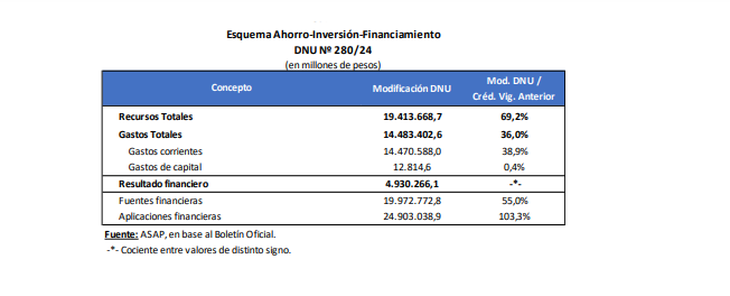with the last DNU 280/2024 known before the extra-long weekendthe executive power increased budget resources by 69% compared to what was up to that moment, and increased spending by 36%. As a result, the financial result improved.
The APN does not include the entire public sector, since it only includes the Central Administration, decentralized organizations, social security entities and state companies.
The 2023 Budget extended At the beginning of Javier Milei’s government – since he refused to deal with the project that Sergio Massa had left behind – he contemplated a financial deficit of $12.2 billion as a product of total resources of $28 billion and expenses of $40.2 billion.
dnu280-2024-iaraf.png
Until now the national government it was managed with that spending pattern without updating due to the effect of inflation, so that although the amount executed was slightly higher than last year, the total planned for the year had remained the same as at the end of 2023, without the items contemplating an update due to the effect of prices.
Now The government added a total of $14.48 to the APN’s spending and, on the other hand, added resources of $19.41 billion. of which results a financial surplus of $4.93 billions. That figure has to be deducted from the loss expected at the start of the year by the old budget of $12.18 billion.
That is to say that with the new adjustments introduced, total spending will remain at $54.53 billion, while resources will rise to $47.41 billion With a new APN financial deficit planned for 2024, it stood at $7.06 billion, 42% lower than at the beginning of the fiscal year. The new APN deficit is equivalent to 13% of total resources.
asap-dnu280-expense.png

That is to say, based on the idea that President Javier Milei has that budgets that have a fiscal deficit cannot be approved, the current one still needs a new update that would allow the gap to be closed.
According to data from the National Public Sector, the government has been producing a spending adjustment of around 40% in the first three months of the year, concentrated more than anything on a liquefaction of pension spending.
The Argentine Association of Budget and Public Financial Administration (ASAP) points out in this regard that “since the levels of Expenses planned in the extension of Budget 2023 for the year 2024 were practically identical to those of that Budget, the current authorizations for expenses for 2024 imply an interannual increase significantly below the expected inflation, which shows that the level of budgeted spending “It will not be enough to cover the needs of the entire year.”
In that sense, he points out that the update by DNU 280/2024 should be interpreted “more as a instrument of an operational nature intended to allow the operation of the National Public Administration in the coming months“, rather than as an allocative and planning instrument, where the multiple public policies that the Government wants to carry out are revealed.”
With the measure, the government authorized higher expenses for 206 budget programs for $14.79 billion, and reductions in 4 programs for $314.635 million.
If analyzed The new expenditure by purpose, the government, with the new structure, increases by 60% the expenditures intended to cover the payment of debts, at $2.7 billion while the Ministry of Human Capital is allocated $7.4 billion with an increase of 37%.
Source: Ambito




